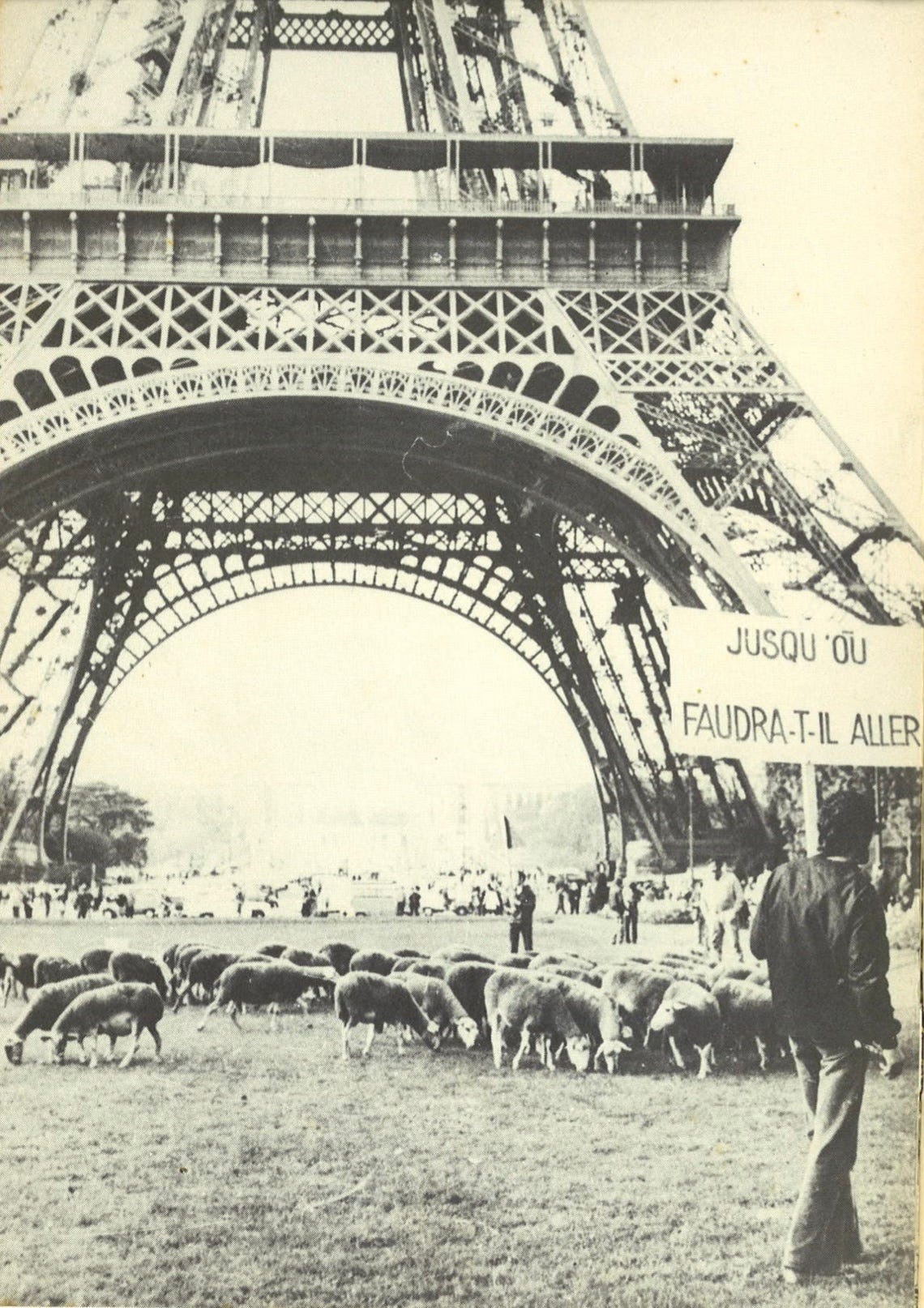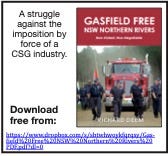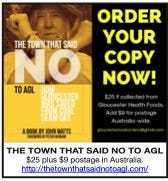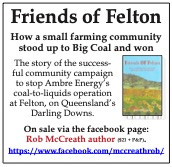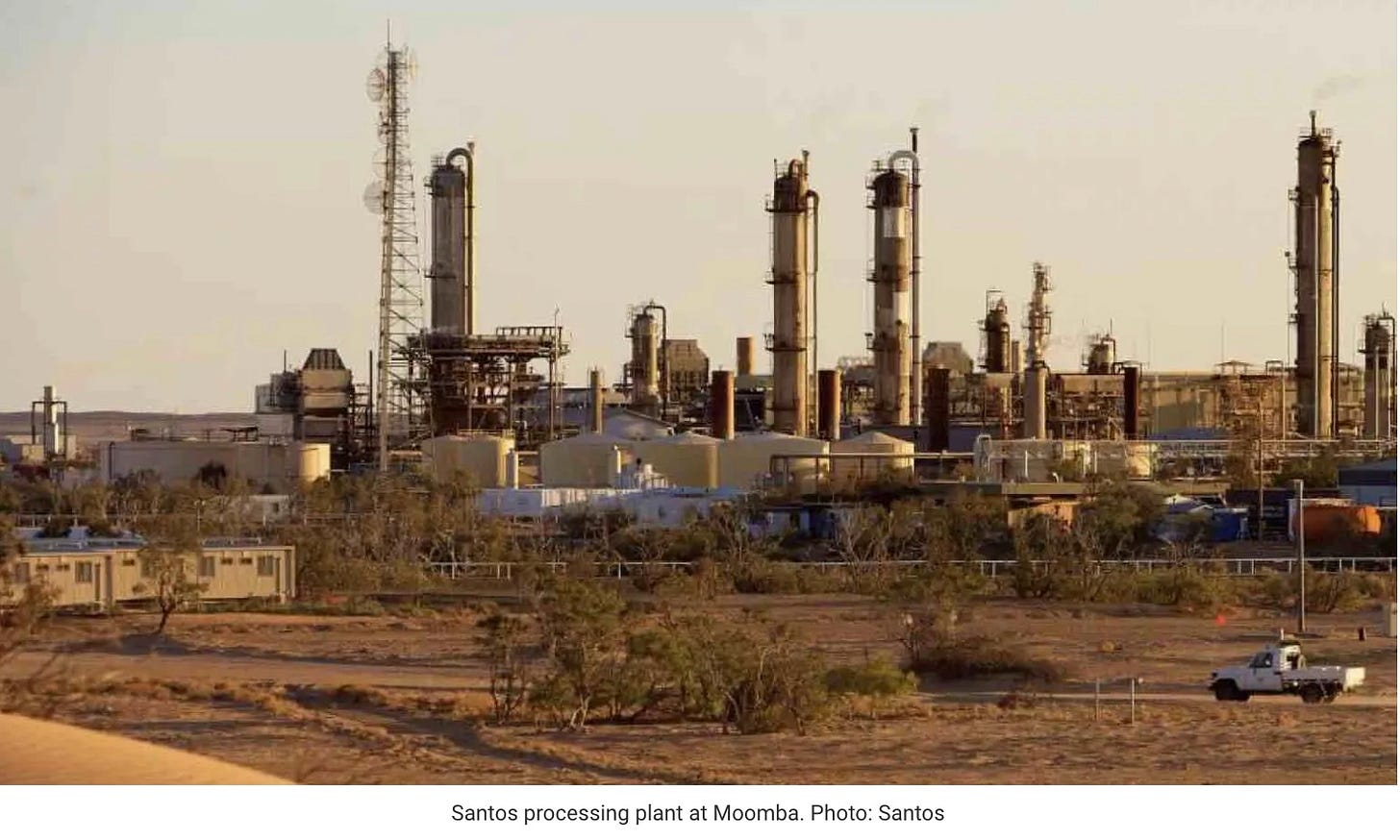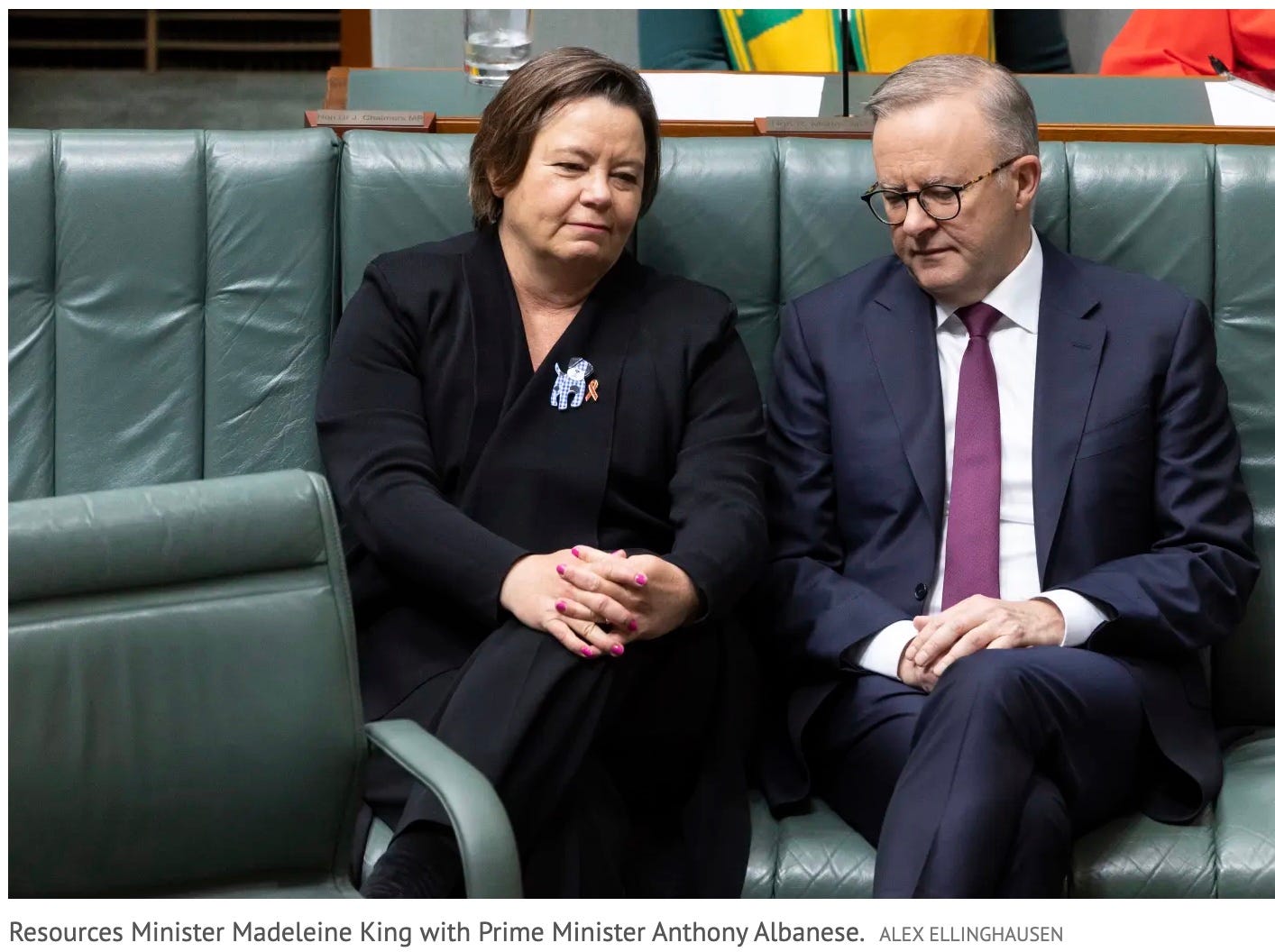Building a web of resistance to fossil fuel projects
Meanwhile, Australians are being gaslit over gas supply
Building a web of resistance to fossil fuel projects
By Eve Sinton
Coal seam gas activist from the Northern Rivers of NSW, Simon Chance, has explained to Focus on Santos how a successful campaign to stop Metgasco from puncturing the region with gaswells drew inspiration from a 20th century event in France.
The lessons are useful for other environmental campaigners such as those working to stop Santos' Narrabri gasfield.
"In the early days of the Northern Rivers campaign we realised that the modus operandi of the coal seam gas (CSG) and coal mining industry was to pick off small communities one by one, he said.
“Being small and isolated kept the communities in a very weak position. Some of us went searching for historical precedencies of successful campaigns where communities had protected themselves from big organisations. There were not many.
"The one that stuck out was the French farmers of the Larzac Plateau who successfully waged a 10-year-long campaign to stop the French military expanding an existing Army base on the plateau.
Above: Peasant farmers protest a military base by grazing sheep under the Eiffel Tower, 1972
"The farmers won by reaching out into the wider community of France, forging coalitions with unions , students and the wider French farming folk.
"This is the template we used to unify the Northern Rivers into a woven web of resistance to CSG.
"It started with forming anti CSG groups in the valleys and small communities then widened to bring in local Councils of the towns and eventually the regional capital, Lismore. The protectors reached out to rural industry groups like Norco.
"The Narrabri folk have been fighting CSG for over a decade and have obviously learned how to organise. There just might be some useful info to be gleaned from the French farmers of the Larzac Plateau."
The Larzac campaign ran from 1971-1981, as peasant farmers and their allies defended the region best known for sheep grazing and production of Roquefort cheese from a massive military base expansion.
They ultimately succeeded when presidential candidate Francois Mitterrand pledged to stop the expansion, and won the election.
A Quaker Peace and Service publication from 1983: Larzac – A Victory for Nonviolence by Roger Rawlinson gives one of the best English language accounts of the campaign.
Amongst Rawlinson's factors for the farmers’ success, he cites:
• Unity of the peasant farmers, who rejected party political involvement and drew inspiration for non-violent action from the teachings of Gandhi;
• Newcomers who were nonviolent activists in the area gave support;
• A nationwide network of Larzac Committees was formed, able to mobilise large numbers of supporters to keep cause in the public eye, and take part in large demonstrations at short notice;
• Francois Mitterrand's election pledge to stop the military base;
• The battle was essentially defensive – the 103 landowners responded to hostile moves by the government but not so much that the government retaliated with devastating powers against them. It was a graduated response and a long, slow haul;
• Constructive civil disobedience in a way that engaged public sympathy for the cause.
One of the most famous images of the campaign was from 1972 when a group of farmers took 60 ewes with 'Save The Larzac' printed on their fleece to Paris, and grazed them on the lawns of the Champ de Mars below the Eiffel Tower.
As well as the Northern Rivers, there are examples of successful community campaigns to stop AGL turning the Gloucester region of NSW into a gasfield, and the Felton community's fight against Ambre Energy's filthy coal-to-liquids project on Queensland's Darling Downs.
Books from these campaigns provide a good account of how they organised themselves, and are recommended reading for groups campaigning against the many climate-destroying industrial projects proposed around Australia. They are illustrated below.
http://thetownthatsaidnotoagl.com/
https://www.facebook.com/mccreathrob/
For further reading about Larzac, see:
https://www.nonviolence.wri-irg.org/en/resources/2019/crops-bring-life-weapons-bring-death-campaign-larzac-plateau
https://nvdatabase.swarthmore.edu/content/larzac-peasants-campaign-block-expansion-military-camp-battle-larzac-1971-1981
https://en.wikipedia.org/wiki/Fight_for_the_Larzac
Australians still being gaslit over gas supply
The Australia Institute
The importance of gas in Australia’s energy market continues to be overinflated in the Australian Energy Market Operator’s annual Gas Statement of Opportunities.
The report, which is based on information from gas industry participants, repeats the pattern of previous years by warning of supply uncertainty and claiming ongoing investment in gas infrastructure is required to meet demand. It also suggests that suggests gas-fired generation plays an ‘important’ role in reducing Australia’s emissions.
“The GSOO appears to be designed to give legitimacy to an industry with decreasing relevance in Australia’s low carbon future. The report acknowledges that demand for gas is ultimately decreasing but suggests new investment is still needed,” said Polly Hemming, climate & energy program director at the Australia Institute.
“As Australian gas exports and profits surge the gas industry is again scaring us into believing there is a gas shortage. The GSOO is informed by the gas industry. Of course, the take-home message of the report is ‘we need more gas’.
“Gas is needed in the short term but the idea that it is helping reduce emissions is manifestly untrue. What Australia needs is an objective equal focus on how to tackle short to medium term supply issues while reducing gas reliance.
“Short and medium-term gas supply issues are the result of Australia being held to ransom by the gas industry. Australians will continue to be faced with skyrocketing prices across the board until this is addressed.
“The answer to any issue of supply over the coming winters is not to invest in more gas infrastructure. It is to speed up the transition to renewable energy.
“Australia doesn’t have a gas supply problem; it’s been made abundantly clear that it has a gas export problem.
“The most effective way to tackle any perceived supply-side issue is to reduce our reliance on gas in the long term and hold the gas industry to account in the short term.”
“While it should come as no surprise that the gas industry wants more investment in gas, it is surprising that in 2023 anyone would still be arguing that fossil fuels have an important role in decarbonising the economy.”
Santos in the News, 10-17 March, 2023
There was not a great deal of media about Santos this week, but we have summarised four stories comprising 1977 words. There's a link to the full story at the end of each item.
A print version of each edition of Focus on Santos can be found at
The teals, farmers and traditional owners fighting Santos
Jane Lee & Gabrielle Chan, The Guardian, 13/03/2023
The rich farmlands of NSW’s Liverpool Plains have long been coveted by fossil fuel companies – BHP and Chinese state-owned Shenhua have both tried and walked away. Now locals are preparing to fight Australian gas giant Santos, which holds the licences for what lies beneath.
The rural and regional editor, Gabrielle Chan, tells Jane Lee about the new generation of farmers taking on Santos, alongside traditional owners and teal independent MPs
(Podcast 25 minutes.)
Upper Hunter seat is one to watch on election night as second most marginal Coalition seat in the state
Louise Nichols, Gloucester Advocate, 14/03/2023
Upper Hunter has changed since the May 2021 by-election that saw the incumbent Nationals Dave Layzell elected with a 5.8 per cent margin. (Mentions Hunter Gas pipeline. Paywalled.)
https://www.gloucesteradvocate.com.au/story/8118430/upper-hunter-is-the-hot-seat/
There is no “gas shortage,” just a shortage of ethics and integrity from the gas cartel
Tim Buckley, Renew Economy, 16/03/2023
The gaslit recovery policy of the previous Coalition federal government has proven to be a farce, but the joke is now on Australian energy consumers.
AEMO’s GSOO, the 20-year supply forecast released on Thursday, highlights looming supply risks and potential shortages, but ignores its own data that shows gas use in the National Electricity Market (NEM) has declined 20% since 2019, and its own forecast that gas use is expected to decline another 60% by 2025.
Accordingly, the AEMO conclusion that more supply is needed to solve rapidly declining domestic demand is entirely counterintuitive.
For a start, the simple fact is that there is no gas shortage; Rather, there is an utter and complete shortage of ethics from the war-profiteering multinational gas cartel.
To ensure domestic supply is prioritised, the government needs to compel the industry to work with integrity to ensure it. Bringing into effect and enforcing the proposed mandatory code of conduct would be a good start, and long overdue.
Arguments for new supply to deal with imminent purported shortfalls fail. Santos’ Narrabri project, for example, and the associated gas pipeline infrastructure that would need to be built to get the gas to market, will take a minimum five years to come online.
This will do nothing to solve any short to medium term domestic supply risks. This approach also risks decades of lock-in of an expensive, volatile, polluting fossil fuel just when we can least afford it, in terms of both the climate and energy price crises.
Yet AEMO advocates for new gas supply like Narrabri as a solution, rather than evaluating genuine alternative solutions that can be deployed faster and more cost-effectively, and that align with Australia’s climate and energy targets.
While all this extortion is going on, the multinational gas cartel is drowning in their tax-free, record high profits of many tens of billions of dollars in 2022 from extracting Australia’s sovereign public resources, even as we all pay the price.
It is undeniable that gas will play a crucial, but small and diminishing role in firming the NEM. Gas peakers operate just 1-2% of the time, but are a vital reliability backup for times of exceptional demand or periods of extended extreme weather.
We also need massively upscaled, near-term public and private investment in grid infrastructure, utility scale wind and solar, pumped hydro storage and more big batteries.
• Tim Buckley is the director of Climate Energy Finance
State, federal governments at loggerheads over fix for winter gas shortfalls
Mike Foley & Nick Toscano, The Age, 17/03/2023
A rift has opened between the eastern states over fresh warnings of winter gas shortfalls, with opinions split over the need for reservation schemes or new gas fields, while the Albanese government approaches a critical decision on imposing unprecedented export controls on gas producers.
The Australian Energy Market Operator (AEMO) has warned gas demand in Victoria – by far the country’s biggest consumer of residential gas – could outstrip supplies as soon as this winter if cold weather drives up heating usage at the same time as a slump in output from wind farms or breakdowns at coal-fired power stations.
As gas fields in Bass Strait, which have traditionally supplied the bulk of east-coast gas demand, are rapidly drying up, AEMO said there would be a risk of shortfalls across the nation’s south-east on days of peak winter demand until 2026.
However, the Andrews government on Thursday rejected the suggestion that more gas supply was needed to prevent shortages, and instead argued a domestic gas-reservation policy should be set up to stop Queensland’s liquefied natural gas (LNG) companies from shipping too much supply offshore.
“There should be no shortage of gas in Australia as we export over 70 per cent of what we produce,” a government spokesperson said. “This is not a supply issue, this is companies putting profit before people.”
Federal Resources Minister Madeleine King declared she wants NSW and Victoria to develop their own gas supplies.
Victoria’s approach is also at odds with NSW. While both states have set themselves ambitious goals to boost renewable energy, NSW is aiming to develop a new project with gas producer Santos, a move backed by King.
“NSW is supporting the development of the Narrabri gas project, which will be used domestically to provide gas for households and businesses,” NSW Treasurer and Energy Minister Matt Kean said.
AEMO’s shortfall warning increases pressure on the federal government to consider a move to restrict exports from the Queensland LNG ventures involving Origin Energy, Shell and Santos.
The government will make a call by April 1 to initiate the first stage of the so-called gas trigger, or Australian Domestic Gas Security Mechanism (ADGSM), which has never been enacted before.
Conservation groups insist projection of shortfalls later this decade leaves ample time for governments to develop a strategy focused on reducing gas demand, such as switching appliances from gas to electric and prohibiting new residential gas connections, rather than lifting supply.
The Australian Petroleum Production and Exploration Association said the AEMO report confirmed the only way to plug the gas supply gap was with more gas supply projects.


